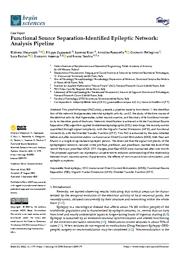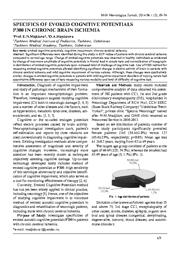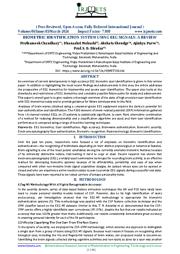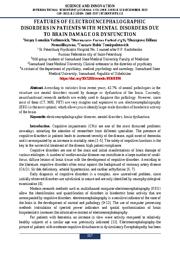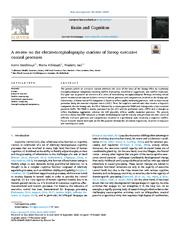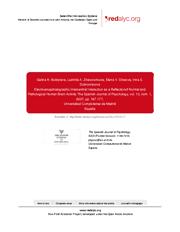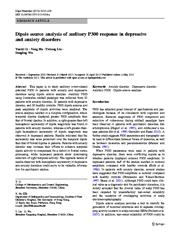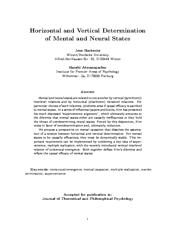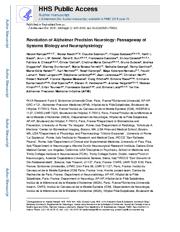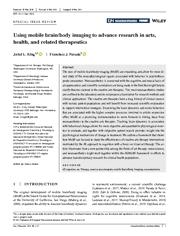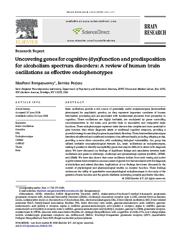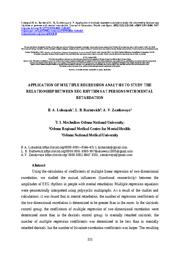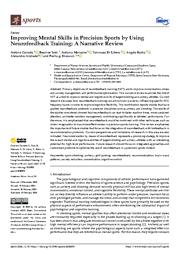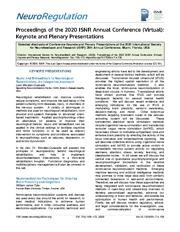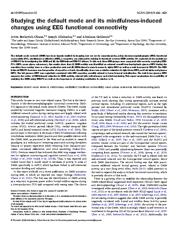A copy of this work was available on the public web and has been preserved in the Wayback Machine. The capture dates from 2022; you can also visit the original URL.
The file type is application/pdf.
Filters
Functional Source Separation-Identified Epileptic Network: Analysis Pipeline
2022
Brain Sciences
Network identification is achieved with the Functional Source Separation (FSS) algorithm applied to electroencephalographic (EEG) recordings, the neurodynamics quantified through signal complexity with ...
activity that it generates, called neurodynamics, and the study of its functional connectivity to the other parts of the brain. ...
FSS identification step. Obtaining individual FS_Epi and FS_rp neurodynamics in resting states of interest. ...
doi:10.3390/brainsci12091179
pmid:36138915
pmcid:PMC9496980
fatcat:b6ecrh4uu5dwpil3uskvqntwue
Specifics of evoked cognitive potentials P300 in chronic brain ischemia
2018
NATIONAL JOURNAL OF NEUROLOGY
Change of evoked cognitive potentials was observed in healthy individuals as evidenced by change of maximum amplitude of cognitive potentials in frontal lead in simple tests and normalization of topographic ...
Use of P300 method for measuring evoked cognitive potentials allowed identifying significant changes in electric activity of brain in patients with chronic cerebral ischemia and mild cognitive impairment ...
Recording and processing evoked cognitive potentials (ECP) was implemented on a personal computer using electroencephalographic analyzer software named Neurosoft EEG-5 (Ivanovo city). ...
doi:10.28942/nnj.v1i5.112
fatcat:ykrdcbfolfesvju4ysh2mjy5ai
BIOMETRIC IDENTIFICATION SYSTEM USING EEG SIGNALS: A REVIEW
2024
International Research Journal of Modernization in Engineering Technology and Science
Next, alternative combination of a method for reducing dimensionality and a classification algorithm are used, and their user identification performance is compared using a range of machine learning techniques ...
Analyses of brain waves obtained using a consumer-grade EEG equipment explore the device's potential for user authentication and identification. ...
Individual Identification Using Cognitive Electroencephalographic Neurodynamics: The suggested neurodynamic connectivity-based user identification system investigates how it might develop into a powerful ...
doi:10.56726/irjmets50246
fatcat:ygxjuco6pfcbxfx7pmtkad7q74
FEATURES OF ELECTROENCEPHALOGRAPHIC DISORDERS IN PATIENTS WITH MENTAL DISORDERS DUE TO BRAIN DAMAGE OR DYSFUNCTION
2023
Zenodo
Currently, neurofunctional research methods are widely used to diagnose this pathology. ...
However, since most of them (CT, MRI, PET) are very complex and expensive to use, electroencephalography (EEG) is the most optimal, which allows you to identify large-scale disorders of bioelectric activity ...
Modern research methods such as multichannel computer electroencephalography (EEG) allow the identification and quantification of disorders in bioelectric brain activity that are accompanied by cognitive ...
doi:10.5281/zenodo.10361197
fatcat:dno4izxkwjerdg44kfudmyoi6i
A review on the electroencephalography markers of Stroop executive control processes
2020
Brain and Cognition
Then, for cognitive control tasks that involve a linguistic component like the Stroop task, the N2 is followed by a centro-posterior N400 and subsequently a late sustained potential (LSP). ...
overview shows that ERP constitute a reliable methodological tool for tracing with precision the time course of different executive processes and sub-processes involved in experimental tasks involving a cognitive ...
., Jensen & Mazaheri, 2010; Klimesch, 2012; Waldhauser, Johansson, & Hanslmayr, 2012) , or beta (13-30 Hz) as a marker of the maintenance of the current sensorimotor or cognitive state (e.g., Engel & ...
doi:10.1016/j.bandc.2020.105637
pmid:33217721
fatcat:w45x5bltizdszd46efaycyyo4m
Electroencephalographic Intercentral Interaction as a Reflection of Normal and Pathological Human Brain Activity
2007
The Spanish Journal of Psychology
Development and regression of pathology in right-and left-handed individuals with organic brain lesions were thought to be caused by these differences. ...
Right- and left-handed individuals showed frequent and regional differences in EEG coherence, which mainly reflected specificity of intracortical relationships. ...
Solid line = normal (n = 50), dotted line = pathology (n = 28). equivalent dipole sources, using the Brainloc method, has allowed the identification of the revealed EEG pattern as a reflection of the activation ...
doi:10.1017/s1138741600006430
fatcat:r4pu6333vbfyhml6izch2xpy2q
Dipole source analysis of auditory P300 response in depressive and anxiety disorders
2011
Cognitive Neurodynamics
This paper is to study auditory event-related potential P300 in patients with anxiety and depressive disorders using dipole source analysis. ...
Auditory P300 using 2-stimulus oddball paradigm was collected from 35 patients with anxiety disorder, 32 patients with depressive disorder, and 30 healthy controls. ...
Open Access This article is distributed under the terms of the Creative Commons Attribution Noncommercial License which permits any noncommercial use, distribution, and reproduction in any medium, provided ...
doi:10.1007/s11571-011-9156-y
pmid:21826191
pmcid:PMC3100469
fatcat:kavean5kkfhhrfo6goq5vhyxke
Horizontal and vertical determination of mental and neural states
2012
Journal of Theoretical and Philosphical Psychology
As a methodological point, our approach links theoretical and empirical results of cognitive neuroscience, in particular cognitive neurodynamics, with philosophical arguments about mental causation, a ...
Our work demonstrates how combining philosophical arguments with novel results in cognitive neurodynamics improves and refines our knowledge about mental causation. ...
doi:10.1037/a0027157
fatcat:ec76srvxv5g7pk2upbh5reojai
Revolution of Alzheimer Precision Neurology. Passageway of Systems Biology and Neurophysiology
2018
Journal of Alzheimer's Disease
path: a combined hypothesis-driven investigation of systems dysfunction within distinct molecular, cellular and large-scale neural network systems in both animal models as well as through tests for the usefulness ...
CONTRIBUTION AND ROLE OF ELECTROENCEPHALOGRAPHY (EEG) Candidate topographic neurophysiological (neurodynamic) biomarkers of AD can be derived from resting state eyes-closed electroencephalographic (rsEEG ...
Identification of in vivo AD pathology has also proven to be relevant in disease identification. ...
doi:10.3233/jad-179932
pmid:29562524
pmcid:PMC6008221
fatcat:j3u6gkzfqbg47kv4o2hpkjadn4
Using mobile brain/body imaging to advance research in arts, health, and related therapeutics
2021
European Journal of Neuroscience
We outline a framework that shows how MoBI can be used to study the effectiveness of creative arts therapy interventions motivated by the 4E approach to cognition with a focus on visual art therapy. ...
The uses of mobile brain/body imaging (MoBI) are expanding and allow for more direct study of the neurophysiological signals associated with behavior in psychotherapeutic encounters. ...
Research using technologies such as electroencephalographic (EEG) (Belkofer et al., 2014; Belkofer & Konopka, 2008; King et al., 2017) , heart rate variability monitoring (Haiblum-Itskovitch et al., ...
doi:10.1111/ejn.15313
pmid:33999462
pmcid:PMC9291922
fatcat:s7yhacjjxjbita47qhiiipxkiu
Uncovering genes for cognitive (dys)function and predisposition for alcoholism spectrum disorders: A review of human brain oscillations as effective endophenotypes
2008
Brain Research
and are associated with fundamental processes from perception to cognition. ...
Brain oscillations provide a rich source of potentially useful endophenotypes (intermediate phenotypes) for psychiatric genetics, as they represent important correlates of human information processing ...
Once genes are identified and understood, risk genotypes and haplotypes can be used in prospective studies of young individuals, and can lead to an improved understanding of how cognitive changes contribute ...
doi:10.1016/j.brainres.2008.06.053
pmid:18634760
pmcid:PMC2814598
fatcat:fagchg3dsvbz7ihjokici5cxai
Application of multiple regression analysis to study the relationship between eeg rhythms at persons with mental retardation
2022
Journal of Education, Health and Sport
Multiple regression equations were geometrically interpreted using polycyclic multigraphs. ...
Using the calculation of coefficients of multiple linear regression of two-dimensional correlation, we studied the mutual influences (functional connectivity) between the amplitudes of EEG rhythms in people ...
The EEG was recorded in a state of calm wakefulness with closed eyes on the Neuron-Spectrum-2 electroencephalograph at a quantization frequency of 500 Hz using a montage: bipolar ring 16. ...
doi:10.12775/jehs.2022.12.02.025
fatcat:6s2vybx7nfgoxizuzi3asy7mw4
Improving Mental Skills in Precision Sports by Using Neurofeedback Training: A Narrative Review
2024
Sports
Future research should focus on integrated approaches and customised protocols to optimise the use of neurofeedback in a precision sports context. ...
This narrative review examines the role of NFT as a tool to improve mental and cognitive skills of target shooting and archery athletes. ...
The athlete's profile, which includes individual neurodynamic indicators, behavioural characteristics, and psychophysiological indicators such as EEG and heart rate variability, have been proposed as a ...
doi:10.3390/sports12030070
pmid:38535733
pmcid:PMC10975073
fatcat:orirkgngvrfinnjdbwfta6jeeq
Proceedings of the 2020 ISNR Annual Conference: Keynote and Plenary Sessions
2020
NeuroRegulation
brain regions as comparably maltreated individuals with severe psychopathology. ...
Further, evidence also suggests that maltreated and nonmaltreated individuals with the same DSM diagnoses are clinically, neurobiologically, and genetically distinct. ...
be a low-cost and viable tool for the early identification of risk of cognitive decline. ...
doi:10.15540/nr.7.4.158
fatcat:34fp4skgzfdifemv4iko35gdva
Studying the default mode and its mindfulness-induced changes using EEG functional connectivity
2013
Social Cognitive and Affective Neuroscience
The default mode network (DMN) has been largely studied by imaging, but not yet by neurodynamics, using electroencephalography (EEG) functional connectivity (FC). mindfulness meditation (MM), a receptive ...
We explored: (i) the usefulness of EEG-FC for investigating the DMN and (ii) the MM-induced EEG-FC effects. ...
The first is the identification of the electroencephalographic functional connectivity (EEG-FC) signature of the default mode network (DMN). ...
doi:10.1093/scan/nst153
pmid:24194576
pmcid:PMC4187278
fatcat:yzwbhiaftncphdxicsnttrrfg4
« Previous
Showing results 1 — 15 out of 87 results

